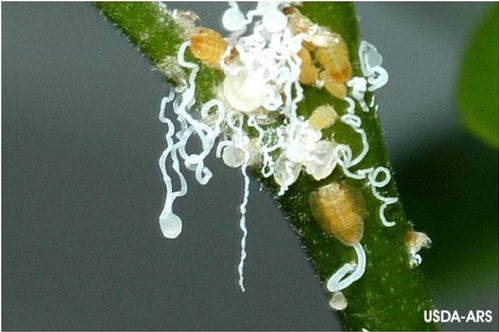Posts Tagged: exotic pests
USDA provides funds for California specialty crops research
The USDA issued a news release on Friday announcing $55 million in block grants to enhance the competitiveness of specialty crops around the country, with California receiving more than $17 million. Of the 64 California projects, 19 are led by researchers affiliated with UC Agriculture and Natural Resources.
A large share of funding - $1.4 million - goes to nine food-safety projects to be coordinated by UC’s Center for Produce Safety, according to an article in the Fresno Bee.
"Scientists and researchers with the University of California and industry groups are exploring everything from whether frogs and lizards are potential carriers of E.coli to whether dust from a cattle operation can carry E.coli into a vegetable field," wrote Bee reporter Robert Rodriguez.
The executive director of the Center for Produce Safety, Bonnie Fernandez, told Rodriguez the funding comes at a time of heightened awareness of food safety among consumers and farmers.
"There are simply a lot of unanswered gaps of knowledge on these issues," Fernandez was quoted. "We want to know where the pathogens came from, how it attaches to a product and how we can reduce the risk of that happening."
Management of exotic pests is another issue where USDA provided funding for UC research, according to the listing on USDA's website. For example, grants will support efforts to:
- Release and evaluate four exotic olive fruit fly parasitoids in order to improve sustainable table and oil olive management
- Test the area-wide application of mating disruption of vine mealybug in Napa County
- Evaluate the efficacy of organic pesticides for Asian Citrus Psyllid control so science-based control recommendations can be made to organic citrus growers
- Survey resistance ratios in olive fruit fly populations from California regions not sampled in a previous study
Funds were also made available to expand and improve the online specialty crop production information now available on UC's Fruit & Nut Research and Information Center website and call-in center.
In addition, the new funding will allow UC researchers to work with several school districts and their regional partners to expand their procurement of local seasonal fresh produce, enhance their ability to integrate a specialty crop nutritional curriculum by providing outreach and professional development to school personnel, and assess changes in food preferences and dietary behaviors of children in participating school.
Other UC projects receiving the funding will look into onion seed production, strawberries' ability to restore impaired insulin, steam injection for soil disinfestation, and mealy plum aphid and leaf-curl plum aphid control in prunes.

The UC Center for Produce Safety to receive substantial research funds from USDA.
UC academics raise Asian citrus psyllid awareness
Be prepared with a plan, warns UC Cooperative Extension farm advisor Craig Kallsen, for the very real possibility of an Asian Citrus Psyllid quarantine area in Kern County, according to an article he authored that was published in Western Farm Press yesterday.If the pest appears in the San Joaquin Valley's southernmost county, farmers will face a distinct challenge. Most of the citrus fruit harvested in Kern County is shipped to other counties for packing. If the county were to be quarantined, farmers would have to make sure the fruit has been processed and cleaned well enough to eliminate all plant parts - including leaves, stems and debris - and all life stages of the Asian citrus psyllid before shipping to packing houses.
"(The fact) that much of Kern County’s fruit is packed outside the county may make compliance with quarantine regulations potentially more difficult for many growers and packers that produce fruit in Kern County," Kallsen wrote.
Meanwhile, an article by freelance writer Dan Bryant, published earlier this week in Western Farm Press, outlined how the citrus industry is gearing up for Huanglongbing, the devastating citrus disease that can be spread by Asian citrus psyllid (to date, the disease has not appeared in California.)
The story included advice from UC Riverside citrus entomologist Beth Grafton-Cardwell. She told the reporter the telltale, early signs of Huanglongbing are yellowing of newly-flushed citrus foliage.
If Huanglongbing arrives in California, it could be distributed rapidly by the Asian citrus psyllid through backyard plants before moving on to commercial citrus. In that case, nurseries will have to place nursery stock in screen houses to keep it from the Asian citrus psyllid. Some, she said, have already prepared structures.

Immature Asian citrus psyllids.
Another attentive dog averts disaster
A FedEx package filled with curry leaves and guavas arrived in Sacramento Wednesday infested with 100 Asian citrus psyllids, the Los Angeles Times reported today. In a scenario eerily similar to one that took place in Fresno two weeks ago, a trained dog alerted authorities to the package, the pests were trapped, analyzed at a lab and determined to be free of the bacteria that causes the citrus disease Huanglongbing (HLB).The package destined for Fresno was mailed from India; the package in Sacramento came from Houston, Texas.
"We know that this has been going on but it is just now that we are getting a feeling for how bad it is as we get more federally funded dog teams out there," the article quoted Beth Grafton-Cardwell, a UC Riverside citrus entomologist based at the UC Lindcove Research and Extension Center in Exeter.
UC scientists are working with CDFA, USDA and the citrus industry to prevent establishment of Asian citrus psyllid in California. But the effort has been met with several recent setbacks. Their greatest fear is for the incurable HLB disease that the psyllid transmits.
Psyllids not infected with HLB were found in Imperial and San Diego counties early last year; this week isolated populations turned up Los Angeles and Orange county backyard citrus trees.
Grafton-Cardwell believes the pests' eventual spread through the state's citrus regions is inevitable.
"It's only a matter of time before the huanglongbing disease finds its way to California from Mexico or elsewhere," Grafton-Cardwell told LA Times reporter Jerry Hirsch.

White, waxy tubules are a tell-tale sign of Asian citrus psyllid.
UC asks Californians to watch for citrus pest
The Los Angeles Times reported this afternoon that Asian citrus psyllid has been found in a Los Angeles County backyard citrus tree. Just yesterday, officials confirmed the pest was found in Orange County. These were the first finds outside of San Diego and Imperial counties, where the exotic pest was first captured in California in early 2008.
UC citrus entomologist Beth Grafton-Cardwell is asking Californians to pitch in on the battle against Asian citrus psyllid, which in other parts of the world carries the devastating citrus disease Huanglongbing (HLB, or citrus greening disease.)
Anyone with a citrus tree in their yard or apartment complex can look closely at the tender young leaves of the late summer and fall citrus flush, the place where immature stages of Asian citrus psyllid congregate. The small, yellowish-orange nymphs extract sap from the tree as they feed. They excrete honeydew, which can turn leaves and fruit black from sooty mold, and they produce tiny white, waxy tubules.
For more information, see http://ucanr.org/detectingpsyllids. For pictures of Asian citrus psyllid and the symptoms to look for in infested trees, see the accompanying video.
DetectingACP2
One quarantine lifted, another imposed
CDFA announced in a news release yesterday that five Asian citrus psyllids were found in the Orange County community of Santa Ana, triggering the first ACP quarantine north of San Diego and Imperial counties.
The northward movement of the psyllid may raise fears of the state's citrus growers, but there is also some good news about the effectiveness of state-sponsored pest eradication programs. CDFA announced in another news release yesterday that a Mediterranean fruit fly infestation San Diego's Spring Valley has been eradicated.
To eradicate the pest, ag officials released nearly 3 million sterile male Medflies over an 11.2 square-mile zone at the core of the quarantine area. Fertile female flies mate with the sterile males but produce no offspring, eventually eradicating the pest.
Medflies can infest over 260 types of fruits and vegetables, threatening California’s crops and exports as well as urban and suburban landscaping and gardens.
CDFA said the new ACP quarantine in Orange County will restrict movement of plant material at wholesale and retail nurseries within five miles of the find site. In addition, the agency is planning a treatment program and monitoring the area to detect additional psyllids.

USDA's ACP map shows where the pest has been found.
